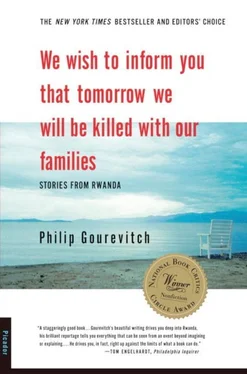Father Dhelo knew that the displaced people were Tutsis fleeing the attacks of Hutus led by the ex-FAR and interahamwe from the UN camps in Goma, which lay about thirty rugged miles southeast of Mokoto. Since early 1996, as some Western governments began to tire of paying for the camps, rumors had proliferated about aid being shut down or the camps being forced to close, and the resident génocidaires and their Zairean Hutu allies had intensified and expanded their war in North Kivu. The effort now appeared to be to “ethnically cleanse” the mountainous agricultural heartland of North Kivu, with the objective of creating a more permanent Hutu Power base, which was already being informally referred to throughout the region as Hutuland.
Father Dhelo knew all this, and he knew that in 1994 the génocidaires had not hesitated to violate the sanctuary of churches in Rwanda. But when local Hutu leaders threatened to kill him for giving sanctuary to the displaced Tutsis at Mokoto, he refused to be intimidated. “I said to them that if they thought my death could solve the problem and I would die alone, I would be content to die,” Father Dhelo told me. “After that, they didn’t come for me.” Then, in early May, Father Dhelo went away on business.
Close to a thousand Tutsis were camped around the monastery at the time. According to Father Victor Bourdeau, a French monk who had lived at Mokoto for seventeen years, a Hutu mob assembled around the camp on the evening of Wednesday, May 8. Shots were fired in the air, and hundreds of Tutsis took refuge inside the church. On Friday, the monastery received warning that a major attack was planned. There was no safe way to move the Tutsis out, but most of the monks were evacuated; Father Victor was one of six who stayed until Sunday, May 12. That morning, Hutu fighters forced their way into the church, dragged some Tutsis outside, and executed them with machetes. “There was nothing to be done,” Father Victor said. He and his fellow monks fled on a tractor.
When I met the Mokoto monks nine days later, they were displaced people themselves, living in temporary quarters in Goma. Father Victor, a tall, slender man with the anxious look of an ascetic, sat in his khaki cassock on a cot in a small stuffy room. “Everybody in the village was an accomplice, by silence or by looting, and it is impossible to divide the responsibility,” he said. “It’s like in Rwanda—one can’t say all of them are guilty, but to sort it out is impossible.” Father Victor had been in Kigali on April 7, 1994, the day after Habyarimana’s assassination, and he told me, “It was exactly the same scenario.”
MOKOTO’S ISOLATION WAS such that it took three days for news of the monastery massacre to reach Kigali, where I was staying at the time. The story fit the pattern of recent events. In the preceding month and a half, at least ten thousand Tutsis had been chased out of North Kivu and forced to take refuge in Rwanda. The Rwandan government had accused Zaire of complicity in their expulsion, since its troops had often trucked Tutsis to the border, then confiscated or ripped up their Zairean citizenship papers. Zairean officials responded by invoking a much disputed and never enforced nationality law, passed in 1981 in violation of Zaire’s own constitution and a host of international legal conventions, that stripped Zaireans of Rwandan ancestry of their citizenship, rendering them stateless. “These refugees from North Kivu are Zaireans,” General Kagame’s adviser, Claude Dusaidi, told me. “We ask for our citizens to return from the camps, and they send us theirs. They must take them back and give us ours.”
As reports of the Mokoto massacre began to circulate in Kigali, similar expressions of outrage greeted me at every Rwandan government office I visited. If Zaire had it in for ancestral Rwandans, I was asked, why were Zairean Tutsis being singled out while Zairean and Rwandan Hutus killed them with impunity? “It’s really a genocide going on again,” Dusaidi said, “but supported by Zaire against its own citizens.” I was repeatedly reminded that Zaire’s President, Mobutu Sese Seko, had backed Habyarimana’s fight against the RPF, facilitated arms shipments to Rwanda during the genocide, provided bases for the French forces of Opération Turquoise, and abetted the resurgent Hutu Power forces in the border camps. A UN investigative team had just published a report showing that the infamous Colonel Bagasora of the ex-FAR traveled under Zairean military papers to the Seychelles to purchase weaponry and munitions. In the first half of 1996, as the war in North Kivu grew fiercer, attacks against Rwanda by the Hutu Power forces in Zaire had also intensified and infiltrators killed hundreds of genocide survivors in an effort that the organization African Rights described as “killing the evidence.” So it particularly galled Rwandan officials that the international community kept pouring money into Zaire by way of the camps, but did nothing to hold Mobutu accountable for the actions of his genocidal guests.
Mobutu was the longest-ruling despot in Africa. His ascent to power, between 1960 and 1965, had been accomplished with the careful assistance of the CIA and various bands of white mercenaries through the violent suppression of the popularly elected Congolese national movement, and his endurance was due, in large measure, to his genius for turning the misery of his neighbors to his own advantage. During the Cold War, the United States and its allies propped him up as a bulwark against Communist forces in central Africa. Then the wall came down in Berlin, and Mobutu was no longer of use. Promoting democracy was the new dispensation, and when Mobutu failed to produce anything but a violent parody of multiparty reforms, his erstwhile Western patrons cut him loose. His immense country—the size of Western Europe or the United States east of the Mississippi—was loaded with cobalt, diamonds, gold, and uranium, and he was rumored to be one of the wealthiest men in the world. But by the end of 1993, as his unpaid army ran riot, murdering, looting, and raping its way through the land, Zaire was enduring ten thousand percent inflation, and Mobutu, ostracized, and unable to get a visa to the United States or Europe, appeared headed for ruin. Then the Rwandan genocide put him back in the spotlight—this time as the man who had to be dealt with if you wanted to deal with the refugees.
Once again, Western leaders turned to Mobutu as a power broker in regional affairs; emissaries of the United States, the European Union, and the UN Secretariat shuttled in and out of Gbadolite, the vast jungle palace where Mobutu held court and where Habyarimana was entombed. France, ever eager to bail out Hutu Power, broke ranks with the rest of what in Cold War parlance used to be called “the free world,” and unilaterally restored aid to Zaire—which meant, of course, to Mobutu, who shoveled the money directly into his Swiss bank accounts. “That genocide,” a European diplomat told me, “was a gift from God for Mobutu.” The Rwandan officials I spoke with believed that Mobutu, by tolerating and even encouraging the creation of a highly militarized Hutuland in Zaire, was seeking to ensure that this gift would keep giving.
“If anybody thinks Mobutu can continue to fool people, I don’t think it’s going to take very long to show people that we’re not fools,” Colonel Karemera, Rwanda’s Minister of Health, warned. The last battalions of UNAMIR had finally withdrawn from Rwanda in April of 1996, and one month later it seemed that the war everyone had been waiting for was getting underway. “Zaire is just provoking and provoking,” Claude Dusaidi told me at the Ministry of Defense. “If Zaire wants to expel its citizens and give them to us, let Zaire give them with their land.” I heard this line so often from officials in Kigali that I asked Dusaidi, who was famously blunt, if Rwanda was preparing to invade Zaire. “We have enough problems,” he said. “We don’t have to go beyond our borders to get frustrated. But if we wanted North Kivu, we would go take it.”
Читать дальше











